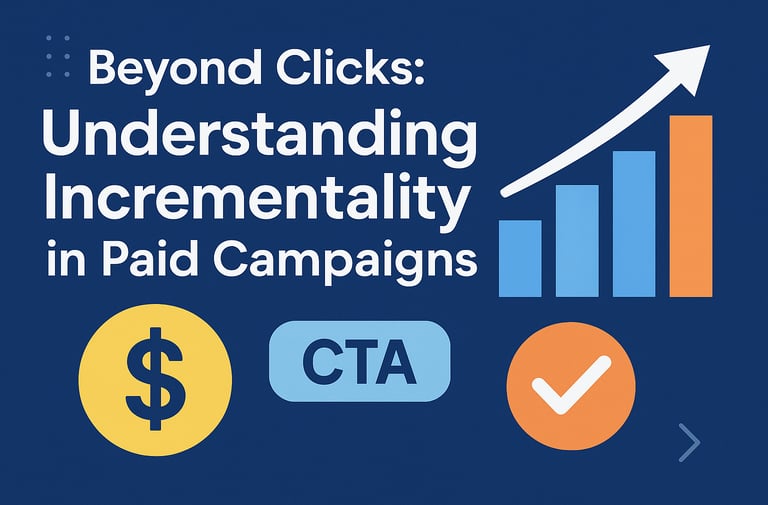Beyond Clicks: Understanding Incrementality in Paid Campaigns
Learn how incrementality helps marketers in 2025 move beyond vanity metrics to measure true campaign impact, optimize budgets, and drive real business growth.
5/28/20253 min read


Beyond Clicks: Understanding Incrementality in Paid Campaigns
Why Incrementality Matters More Than Ever
For years, marketers have measured success through clicks, impressions, and conversions. But in 2025, those surface-level metrics no longer tell the full story. With privacy updates, tracking limitations, and AI-driven ad delivery, understanding what’s truly driving results has become critical.
That’s where incrementality comes in — the metric that separates genuine impact from noise.
A recent Meta study found that nearly 40% of ad spend delivers little to no incremental lift when measured under traditional attribution models. That means a large share of marketing budgets may be overestimated.
What Incrementality Really Means
Incrementality measures how much of your campaign’s success was actually caused by your ads — not what would have happened on its own.
It answers one powerful question:
“If we stopped these ads, would our results change?”
Unlike traditional attribution, which credits clicks or impressions, incrementality reveals causal impact — helping you understand which campaigns, audiences, and creatives truly move your business forward.
Why It’s a Game-Changer in 2025
The loss of third-party cookies and privacy-first ad ecosystems have created major blind spots in performance reporting. Platforms like Meta and Google often model conversions based on incomplete data — making marketers believe campaigns are performing better than they are.
For growing brands in India and Pune, this makes incrementality testing even more important. It helps you:
Identify true ROI instead of vanity metrics
Optimize ad spend by cutting waste
Reveal which campaigns genuinely drive incremental growth
Build stronger business cases for marketing budgets
Proven Ways to Measure Incrementality
There are several ways to design an incrementality test, depending on your campaign type and scale:
1. Geo Testing (Matched Markets)
Compare two similar regions — for instance, run ads in Pune and pause them in Nagpur. Measure the difference in sales or leads.
2. Ghost Ads
Expose one audience to your ads and withhold them from another identical group. Google and Meta offer built-in frameworks for this method.
3. PSA or Placebo Ads
Run neutral “dummy” ads for a control group to isolate the true behavioral impact of your actual campaign.
4. Audience Holdouts
Exclude a percentage of your audience from your campaign for a set period. Compare results afterward to measure real lift.
Metrics That Really Matter
When analyzing incrementality tests, these are the numbers that reveal real business growth:
MetricWhat It MeasuresIncremental ConversionsExtra sales or leads caused by your adsIncremental RevenueAdditional revenue vs. control groupLift PercentageGrowth compared to the baselineCost per Incremental Conversion (CPiC)How much you spend for each additional conversionHalo EffectIndirect gains like higher organic search or improved brand recall
Example: A Pune-based D2C skincare brand discovered that 27% of its reported conversions on Meta were organic, not ad-driven. By reallocating budgets using incrementality testing, it saved ₹3 lakh per quarter.
Common Pitfalls and How to Avoid Them
Incrementality testing is powerful — but it’s easy to get wrong if not executed carefully.
Avoid these common mistakes:
Using too-small control groups, which can produce unreliable results
Running tests for too short a duration
Ignoring seasonality or regional buying behavior
Choosing unequal audience groups (e.g., test vs. control not demographically similar)
Overlapping audiences between test and control
Pro Tip: Before running any test, confirm your groups are statistically similar and large enough to produce meaningful data.
From Data to Strategy: The Role of Incrementality
Incrementality isn’t just a reporting metric — it’s a strategic decision-making tool.
When you understand which campaigns truly create lift, you can:
Redirect budgets to high-performing campaigns
Improve creative and targeting efficiency
Strengthen marketing attribution models
Prove real marketing ROI to leadership
For marketers in India, where every rupee counts, incrementality testing ensures that every campaign delivers measurable business outcomes — not just impressive dashboards.
Looking Ahead: Incrementality in the AI Era
AI-driven campaign optimization is reshaping digital marketing, but it also hides key performance signals. As automation grows, incrementality testing becomes your truth detector — the way to validate what the platforms report.
In the future, AI tools will help predict and simulate incremental lift, making experiments faster and more precise. But no matter how smart the tech becomes, understanding causality will remain the ultimate advantage.
The future of performance marketing isn’t more data — it’s better evidence.
Conclusion: Measure What Truly Matters
Incrementality separates what’s effective from what’s merely visible. It helps marketers cut through vanity metrics, eliminate waste, and prove real business impact.
If your brand wants to uncover what’s truly driving growth, it’s time to run your first incrementality test.
Get in touch with our team to schedule an Incrementality Audit or Strategy Session and start making every marketing rupee count.



